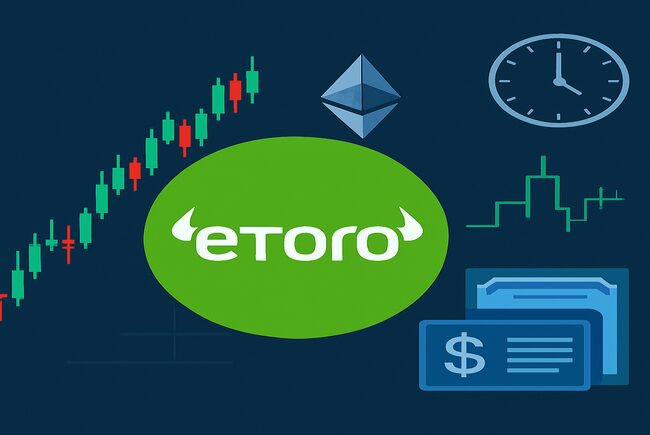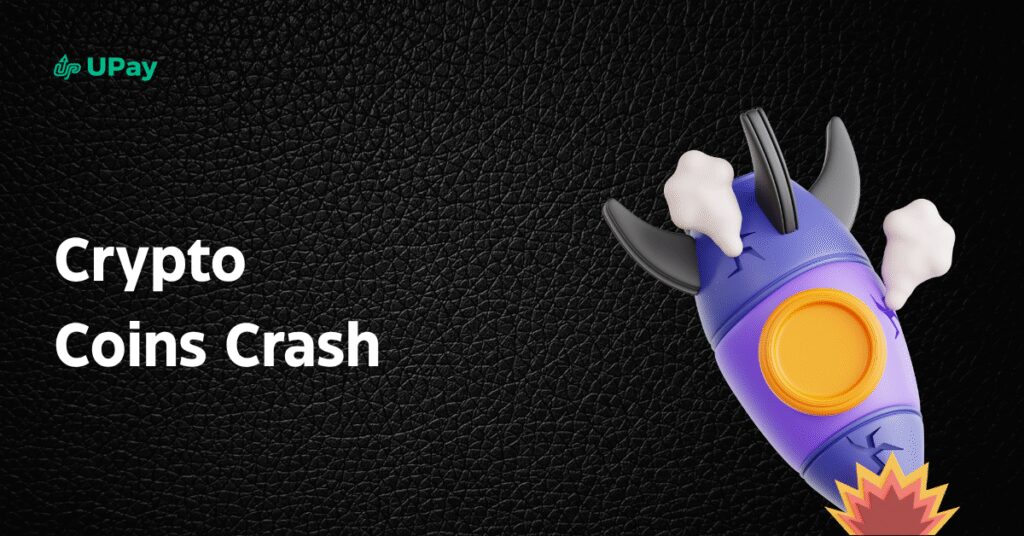eToro Expands Trading Hours, Moves Toward Tokenized U.S. Equities

Trading platform eToro Group Ltd. announced plans to extend trading to 24 hours a day, five days a week, for select U.S.-listed equities and exchange-traded funds, as part of broader efforts to introduce tokenized stocks on the Ethereum blockchain. The initiative, announced during a company webinar on Tuesday, aims to provide retail investors with greater flexibility to trade outside traditional market hours. The new trading schedule will initially apply to 100 popular U.S.-listed stocks and ETFs, according to the company. eToro, founded in 2007 and based in Tel Aviv, currently serves 40 million registered users across 75 countries. Tokenized Assets and Futures Products As part of its long-term strategy, eToro also plans to launch ERC20 tokens representing U.S.-listed equities. The company said this effort builds on its prior tokenization projects, including digital versions of gold, silver and fiat currencies introduced after acquiring Danish blockchain firm Firmo in 2019. eToro’s leadership has signalled a goal of eventually tokenizing all assets on its platform. Yoni Assia, eToro’s co-founder and CEO, said in the webinar that enabling blockchain-based trading could help integrate traditional assets into decentralized finance networks. In addition, the company has introduced spot-quoted futures contracts in partnership with CME Group, which are already available in select European markets. These contracts use spot-based pricing and longer expiries, with plans for a broader rollout. The announcements come amid regulatory changes affecting digital assets, including the European Union’s Markets in Crypto-Assets (MiCA) regulation and the proposed Genius Act in the United States. Both aim to clarify oversight of tokenized real-world assets. Financial Position and Analyst Ratings eToro reported a market capitalization of roughly $5.3 billion, supported by financial indicators including a price-to-earnings ratio of 7.55 and a current ratio of 3.51, reflecting liquidity strength. The company recently secured a three-year, $250 million senior unsecured revolving credit facility, which remains undrawn. eToro said the facility would help maintain financial flexibility as it pursues strategic growth plans.
The Essential Steps on How to Invest in Memecoins in 2025

Meme coins now claim the largest market share at 22.49%, outpacing major blockchains like Solana and Ethereum. Investing in meme coins has become one of caution as fortunes are made and lost in the blink of an eye. Not surprisingly, 40,000 to 50,000 new meme tokens are created daily with some days seeing a staggering 100,000 new tokens during viral moments. But here’s the question- Is it profitable to invest in meme coins? How safe is the system? Is it even worth it? This guide covers every detail on how to invest in meme coins and navigate it’s system. Grab a jotter and let us begin. Key Takeaways What are Meme coins? Memecoins are from the root word ‘meme’. A meme is an interesting or humorous item that is widely spread online, especially on social media. Its purpose is to serve as some form of comic relief from the daily hassles of life online and offline. Do you see where we’re getting at? A memecoin, unlike other cryptocurrencies, is born from humor. Its prosperity is situated at the heart of the internet. The more viral it goes and is worshipped online, the more its worth becomes. Some examples of memecoins are: Why Invest in Memecoins? Before a ‘how’, there’s always a ‘why’. Apart from whatever reason that has spiked your interest in meme coins, let’s be real and talk about why we should invest in memecoins. Is it worth investing in? While some celebrities and investors have actively bought and invested in meme coins for the sake of not being left out of the community enthusiasm, here are perhaps five other reasons people invest in memecoins: Current Market Trends in Memecoins Staying up-to-date on market sentiment and trends on memecoins is as important as investing in them. Investors can capitalize on potential growth while avoiding common scams and pitfalls. Cryptocurrency market trends in 2025 show the meme coin market’s high volatility and speculative nature, and how investors must approach with caution and a clear understanding of the trends and risks involved. The current trends and sentiments surrounding memecoins in 2025 entail: 1. High Growth Potential Experts predict a “meme coin super cycle” in 2025, with the total meme coin market cap potentially reaching $1 trillion. Some meme coins are expected to exceed $100 billion in valuation. The current total meme coin market is approximately $40 billion. 2. Increased Adoption Memecoins have become a dominant force in the digital asset space, with millions of new coins being created daily. The market is expected to continue growing, driven by community engagement, social media trends, and public sentiment. The new meme coin market segment is around $8 billion. 3. High Volatility Memecoins are highly unpredictable, with prices surging and plummeting rapidly. The traditional altcoin market is about $800 billion. 4. New Token Emergence New tokens, including those launched by prominent figures like Donald Trump’s firm, World Liberty Financial, have garnered significant attention. Tokens like $TRUMP and $MELANIA have experienced initial surges in value, despite volatility. 5. Market Dynamics Meme coins are known for their peculiar nature, with prices heavily influenced by social media trends and public sentiment. This makes them susceptible to rapid price fluctuations. 6. Community-Driven Memecoins thrive on community engagement, with investors drawn to strong community support and social media buzz. $155 billion worth of unlocks in traditional crypto, which could create significant selling pressure. 7. Lack of Intrinsic Value Memecoins often lack built-in functionality and are speculative assets. The meme coin market in 2025 is expected to be shaped by a combination of factors, including regulatory developments, technological advancements, and market sentiment. Top Platforms for Buying and Trading Memecoins One thing is to buy memecoins, another is to know where to put them for maximum returns. Below are popular platforms for buying and trading memecoins: 1. UEEx UEEx has rapidly positioned itself as a leading platform in the world of memecoin trading, thanks to its unique combination of security, accessibility, and innovation. Within the personal finance space, where risk management and informed decision-making are critical, UEEx offers an environment that balances high growth potential with a strong foundation of trust and user support. 2. Moonshot If you’re looking for a mobile-first experience, Moonshot is the way to go. This Web3 application lets you discover and trade meme coins on Solana, with diverse payment options like credit cards, Apple Pay, and PayPal. Plus, it offers real-time market insights to help you make informed decisions. 3. SunPump TRON’s answer to the meme coin craze, SunPump offers low-cost token creation and trading on TRON’s high-speed blockchain. With a bonding curve model, liquidity integration, and promotional support from Justin Sun, this platform is worth checking out. 4. Move Pump If you’re interested in fair meme coin launches, Move Pump is a great option. This platform enables users to create and trade meme coins efficiently on Sui and Aptos blockchains, integrating with Bluemove DEX for enhanced liquidity. 5. DEXRabbit This platform monitors cryptocurrency pairs across multiple blockchain networks, providing real-time data on token trading activity. With Smart Order Routing (SOR), you can find the best prices across exchanges and trade on various decentralized exchanges. 6. DEXTools If you’re looking for a platform with real-time pricing data, customizable search filters, and a pool explorer feature, DEXTools is a great choice. It helps you monitor liquidity trends and make informed decisions. Regulatory Frameworks for Memecoins Investment Memecoins are generally not regulated. This is because they’re decentralized and often driven by community enthusiasm rather than traditional values. Many places haven’t figured out exactly how to handle them yet. General cryptocurrency rules around fraud and investor protection do apply, but meme coins often find themselves in a bit of a regulatory limbo. As they become more popular, authorities are working hard to address the risks, but it’s proving to be a tough challenge to get everyone on the same page. According to the Security Exchange Commission- SEC, the staff statement on memecoins says that persons who participate in
What Makes the Best Crypto Mining Hosting in 2025?

Struggling with high electricity bills, noisy rigs, and inconsistent uptime at home? You’re not alone. As mining becomes more competitive and energy-intensive, home setups are no longer the most efficient choice. That’s why more miners are turning to the best crypto mining hosting services giving their hardware a cooler, cheaper, and more secure home. In this article, we’ll examine the top hosting options, what to look for in a provider, the best global locations, and how to choose a setup that maximizes your mining potential in 2025 and beyond. Key Takeaways What is Crypto Mining Hosting? Crypto mining hosting is a service that allows individuals or companies to run their mining hardware in a third-party facility. Instead of setting up miners at home or in an office, users send their mining equipment to a data center that provides electricity, cooling, internet connectivity, physical security, and technical support. These facilities are built to handle the high energy demands and heat output of mining rigs, ensuring stable and efficient operation. Hosting is especially important in crypto mining because it reduces the overhead and technical burden on the miner. You can avoid issues like power outages, overheating, or local regulatory restrictions by using a professional setup. This kind of service is ideal for anyone who owns mining machines but lacks the space, infrastructure, or time to manage them. Hobbyists, small businesses, and large-scale investors all use mining hosting to improve performance and reduce operational risks. For example, a solo miner in a city with high electricity costs might send their equipment to a hosting facility in Texas or Iceland, where electricity is cheaper and cooling is easier due to the climate. Key Features to Look for in a Crypto Mining Hosting Provider Not all crypto mining hosts are created equal here are the important features to consider before choosing one. 1. Electricity Costs and Power Availability Electricity is one of the most significant expenses in crypto mining. Hosting providers that offer competitive electricity rates can help reduce operational costs. Some facilities leverage renewable energy sources, such as hydroelectric or solar power, to provide more sustainable and cost-effective solutions. It’s essential to consider the availability and reliability of power at the hosting facility. Providers with redundant power systems and backup generators ensure continuous operation, minimizing downtime and potential revenue loss. For instance, EZ Blockchain offers hosting facilities powered by nuclear energy, providing a stable and emission-free power supply for mining operations. 2. Cooling Infrastructure and Environmental Controls Mining equipment generates substantial heat, necessitating effective cooling systems to maintain optimal performance. Hosting providers should have advanced cooling infrastructure, such as temperature-controlled environments and efficient airflow systems, to prevent overheating. Proper environmental controls not only enhance equipment longevity but also improve energy efficiency. Facilities that operate in cooler climates or utilize immersion cooling technologies can offer additional benefits in terms of reduced cooling costs and improved hardware performance. For example, EZ Blockchain’s mobile data centers are equipped with sensors to maintain consistent temperatures, ensuring the mining hardware operates within optimal conditions. 3. Network Uptime and Internet Speed Reliable network connectivity is important for uninterrupted mining operations. Hosting providers should offer high-speed internet connections with minimal latency to ensure efficient data transmission and communication with mining pools. Providers that guarantee high network uptime, typically 99.9% or above, help minimize downtime and maintain consistent mining performance. Redundant internet connections and backup systems further enhance reliability, ensuring continuous operation even during network disruptions. For instance, EZ Blockchain provides redundant high-speed fiber optic and cable internet connections, ensuring consistent hashing power and minimizing potential losses due to connectivity issues. 4. Security Measures (Physical and Cybersecurity) Protecting valuable mining equipment and data is paramount. Hosting providers should implement robust physical security measures, including 24/7 surveillance, access controls, and on-site security personnel, to prevent unauthorized access and theft. Cybersecurity is equally important. Providers should employ firewalls, intrusion detection systems, and regular security audits to safeguard against cyber threats and ensure the integrity of mining operations. For example, EZ Blockchain’s facilities feature comprehensive security measures, including recorded video surveillance, motion sensors, and robust network security protocols, prioritizing the safety and security of hosted hardware. 5. Scalability and Flexibility As mining operations grow, the ability to scale resources becomes essential. Hosting providers should offer scalable solutions that allow miners to expand their operations without significant logistical challenges. Flexible hosting options, such as customizable configurations and adaptable contracts, enable miners to adjust their operations based on market conditions and technological advancements. For instance, EZ Blockchain’s high-capacity mobile data centers provide turn-key solutions that can be strategically placed close to power supplies, facilitating seamless expansion of mining operations. 6. Transparency and Monitoring Tools Transparency in operations and access to real-time monitoring tools are important for managing mining activities effectively. Hosting providers should offer dashboards that display key metrics, such as hash rates, energy consumption, and hardware performance, enabling miners to make informed decisions. Regular updates and clear communication from the hosting provider help build trust and ensure that miners are aware of any issues or changes affecting their operations. For instance, EZ Blockchain provides secure remote access to hosted hardware, allowing clients to monitor all necessary data and maintain oversight of their mining operations. Types of Crypto Mining Hosting Crypto mining hosting comes in several forms, each offering different levels of control, cost, and support. 1. Shared Hosting Shared hosting allows multiple miners to use the same facility and infrastructure. Each user rents a portion of the available space, power, and cooling systems. This setup is similar to shared web hosting, where resources are distributed among various users. This option is cost-effective, making it suitable for beginners or small-scale miners. However, since resources are shared, performance can vary based on the activity of other users. Also, users have limited control over the environment and configurations. For example, a miner using shared hosting might experience fluctuations in hash rates if other users increase their usage. It’s important to choose a reputable provider that ensures fair resource
Crypto Coins Crash 2025: What Investors Missed and How to Stay Ahead

In less than 48 hours, over $860 million in crypto positions were liquidated. Bitcoin plunged 15%, Ethereum followed, and major altcoins like Solana, Dogecoin, and XRP bled double digits. The crypto coins crash of 2025 didn’t just test portfolios, it shattered illusions of invincibility in a bull-biased market. What caused this sudden nosedive? Was it purely market mechanics, or did we ignore flashing red signals? In this article, we break down what triggered the crash, which coins suffered most, the role of hacks and memecoins, and most importantly, how smart investors are adjusting their strategies to survive and thrive in today’s volatile crypto landscape. Key Takeaways The Timeline of the 2025 Crypto Crash The first major shockwave of 2025 struck in late February when Bitcoin dropped from over $100K to $90K in just three days, triggering a domino effect across altcoins. Ethereum slid by over 12%, and coins like Solana, Dogecoin, and XRP experienced weekly declines of 15–25%. By February 25, liquidation events intensified. According to CoinGape, over $860 million in leveraged positions were wiped out across Binance, Bybit, and OKX, as stop-losses and margin calls cascaded through the market. This was followed by sharp drops in sentiment metrics. Fear & Greed Index readings flipped from Greed (71) to Extreme Fear (22) almost overnight. Meanwhile, Glassnode’s on-chain data showed a spike in BTC inflows to exchanges, signaling panic selling. The crash didn’t come from a single event but a combination of factors: Each event intensified market volatility, exposing just how fragile overbought conditions had become. Top Altcoins that Hit Hard in 2025 Crypto Crash During the February 2025 crash, not all coins fell equally. Some altcoins with weaker fundamentals or excessive leverage exposure suffered the most severe losses. Here are a few of the most affected tokens: Coin % Loss Sector SOL -21.6% Layer 1 Blockchain DOGE -18.9% Memecoin XRP -17.4% Payments ADA -16.8% Smart Contracts SHIB -15.2% Memecoin The drop in Solana was largely tied to network congestion issues and whale dumping. XRP and ADA, which had recently rallied on regulatory optimism, were hit hard when the SEC delayed token classification guidelines. Memecoins like DOGE and SHIB collapsed under speculative pressure, showing how quickly sentiment can evaporate when the broader market enters risk-off mode. Root Causes of Crypto Coins Crash in 2025 While mainstream coverage often blames crypto crashes on volatility, the 2025 meltdown revealed deeper systemic issues that went ignored by retail traders and even some institutions. 1. Excessive Leverage: Crypto markets were highly overleveraged going into February. Open interest in BTC and ETH perpetual futures hit all-time highs, while funding rates remained elevated. This created a powder keg scenario, when prices dipped slightly, auto-liquidations triggered chain reactions, intensifying the sell-off. 2. Regulatory Tension: Ongoing uncertainty over U.S. crypto regulations, especially regarding the SEC’s delay on altcoin classification and stablecoin guidelines, caused panic. This was worsened by Trump’s 2025 trade policy hints, which sparked broader risk-off behavior in global markets. 3. Hack-Induced Fear: The Lazarus Group’s $1.5B ETH heist from Bybit acted as a psychological blow to investor confidence. Trust in CEX (centralized exchange) security sharply declined, pushing users toward withdrawals, further driving down liquidity. 4. Memecoin Collapse: Tokens like $HAWK and $LIBRA, which were heavily hyped and even politically connected (e.g., in Argentina), crashed 90–100%, causing disproportionate pain for newer investors who FOMO’d in during the top. How Crypto Hacks, Leverage & Memecoins Made It Worse The 2025 crash turned into a full-blown panic due to compounding structural triggers and speculative excess, creating what analysts call a triple threat to market stability: 1. Exchange Exploits & Hacks On February 21, the Lazarus Group executed the largest crypto hack to date by draining approximately 400,000 ETH (~$1.5 billion) from Bybit’s cold wallet via a disguised multisig interface exploit. The breach caused a sharp 24% plunge in ETH prices, pushed Bitcoin below $90K, and sparked massive CEX withdrawals, escalating the liquidity crisis. 2. Excessive Leverage Across Markets Leverage on derivatives hit pre-2022 highs, with retail traders using 10x–20x positions and funding rates at extremes. As prices dropped, auto-liquidations cascaded, wiping out over $860 million in leveraged bets in under two days. This deleveraging spiral magnified market gyrations. 3. The Memecoin Implosion Sick memes hurt real wallets, projects like $HAWK, $LIBRA, and $PEPE2.0 fell 90–100%, wiping out speculator capital and spreading panic across social platforms . These tokens, often hyped by influencers and lacking robust fundamentals, suddenly became toxic assets within portfolios. Institutional Crypto Traders and Their Market Reactions in 2025 Institutional investors, often considered the smart money in the market, did not escape the wrath of the 2025 crash. Major funds like ARK Invest and Grayscale saw multi-billion-dollar drawdowns, with many of their crypto positions hitting stop-loss levels. According to Bloomberg, Grayscale’s Bitcoin Trust (GBTC) lost over 30% of its net asset value in Q2 alone. Rather than panic selling, however, many institutions rebalanced their portfolios, shifting allocations toward stablecoins or tokenized real-world assets (RWAs). A noticeable trend was the redeployment of capital into Ethereum staking derivatives like Lido (LDO) and Rocket Pool (RPL), which were perceived as more sustainable during market downturns. Examples of some of these institutions are: Institutions didn’t rush for exits, they rotated capital, pivoted to staking instruments for yield (e.g., Lido, Rocket Pool), and dipped into tokenized real-world assets (RWAs) like treasuries and corporate bonds via platforms like Ondo Finance and Franklin Templeton. This was a transformation toward regulated, yield-bearing digital assets. Some institutional players also began exploring tokenized treasuries and bonds via platforms like Ondo Finance and Franklin Templeton’s on-chain offerings, signaling a cautious pivot to regulated digital assets. Note: Institutional players didn’t entirely pull out of crypto, they’re hedging, diversifying, and moving closer to regulatory clarity, a sign that big money is still interested, just more selective. What to Learn from Crypto Investors After the 2025 Crash The 2025 crypto crash served as a sobering reminder that even bullish markets can crumble under the weight of overleveraged speculation and macroeconomic shifts. For investors
5 Best Travel Cards for Fair Credit

Neither excellent nor poor, fair credit falls right in the middle. If your credit score isn’t perfect but also not too bad, you may still have good options when it comes to travel credit cards. These cards can help you earn rewards, save on travel expenses, and even help build your credit over time. In this article, we’ll look at some of the best travel cards for people with fair credit so that you can travel smarter, even without top-tier credit. Key Takeaway Cards Annual Fees Rewards Credit Score Best for Credit One Bank Wander Card $95 10x points on eligible hotels and car rentals. Fair – Good Travel Spend Bonuses Capital One QuicksilverOne Credit Card $39 1.5% cash back on every purchase No credit history Cash Back Card for International Travel Bank of America® Customized Cash Rewards Secured Credit Card $0 2 – 3% Cashback No credit history Cash Back Rewards on Everyday Spending Category Discover it® Secured Credit Card $0 2% cash back at gas stations and restaurants No credit history Gas and Dining Purchases. Citi Double Cash® Card $0 2% cash back on all purchases Fair credit Cash Back Card for International Travel 5 Best Travel Cards for Fair Credit These are five of the best travel credit cards for fair credit. They offer helpful rewards, useful perks, and a chance to save on travel, even if your credit score isn’t perfect. Credit One Bank Wander Card The first card on the list is the Credit One Bank Wander Card. It’s designed for travelers with fair to good credit who want to earn strong rewards on travel, dining, and gas purchases. Although it has a $95 annual fee, the card offers valuable points and travel perks that can make it worth the cost. Best: Travel Spend Bonuses Rewards: 10x points on eligible hotels and car rentals. Credit score needed: Fair – Good Annual fees: $95 Pros Cons Source: Credit One Capital One QuicksilverOne Credit Card This card is a good option for people with fair credit who want simple cash-back rewards and travel perks. It offers 1.5% cash back on all purchases and 5% back on hotels and rental cars booked through Capital One Travel. It has no foreign transaction fees, making it helpful for international travelers. However, it comes with a yearly fee and a high APR. Best: Cash Back Card for International Travel. Rewards: 1.5% cash back on every purchase Credit score needed: No credit history. Annual fees: $39 Pros Cons Source: Capital one Bank of America® Customized Cash Rewards Secured Credit Card This card offers tiered cash back rates and no annual fee. It requires a refundable security deposit starting at $200, making it easier to qualify even with poor credit. You put down a refundable security deposit starting at $200 to open the account. The card offers 3% cash back in one category of your choice each quarter, 2% cash back at grocery stores and wholesale clubs, and 1% on all other purchases. Best: Cash Back Rewards on Everyday Spending Categories. Rewards: 2 – 3% Cashback Credit score needed: No credit history Annual fees: None Pros Cons Source: Bankrate Discover it® Secured Credit Card Discover it® Secured Card requires a refundable security deposit and offers the chance to increase your credit score with responsible use. The card earns 2% cash back at gas stations and restaurants (up to $1,000 each quarter) and 1% on all other purchases. Plus, it matches all the cash back you earn in your first year, doubling your rewards automatically. Best: Gas and Dining Purchases. Rewards: 2% cash back at gas stations and restaurants Credit score needed: No credit history Annual fees: 0$ Pros Cons Source: Discover it Citi Double Cash® Card The last option is the Citi Double Cash® Card, a top choice for those with fair credit who want simple, high cash-back rewards. It offers a straightforward 2% cash back on all purchases, 1% when you buy, and another 1% when you pay your bill. Plus, you can earn 5% cash back on hotels, car rentals, and attractions booked through the Citi Travel® portal. Best: Cash Back Card for International Travel. Rewards: 2% cash back on all purchases Credit score needed: Fair credit Annual fees: N/A Pros Cons Source: Citi How to Choose a Credit Card for Fair Credit Choosing a credit card when you have fair credit means looking closely at what each card offers and how it fits your needs. Here’s how to pick the right one: Look at Rewards That Match Your Lifestyle Some cards give bonus points or cash back on travel, dining, or gas. If you travel often, a card like the Credit One Bank Wander Card or Capital One QuicksilverOne might work well. If you want everyday cash back, cards like the Bank of America Customized Cash Rewards Secured Card or the Discover it Secured offer good rewards on daily spending. Check Fees and Interest Rates Many cards for fair credit have annual fees or higher interest rates. Make sure you understand these costs before applying. For example, the Credit One Bank Wander Card has a $95 annual fee, while the Citi Double Cash Card has no annual fee but charges a 3% foreign transaction fee. Consider Security Deposits Secured cards like the Bank of America Customized Cash Rewards and Discover it Secured require a refundable deposit. These are good if you have poor credit or no credit history and want to build or rebuild your credit. Think About Travel Perks Some cards offer extra travel benefits like discounts, upgrades, or extra cash back on bookings through their travel portals. If you want these perks, choose cards that offer them, like the Citi Double Cash or Credit One Bank Wander Card. Watch for Bonus Offers and Intro APR A welcome bonus or an introductory 0% APR on purchases or balance transfers can save you money. For example, the Citi Double Cash Card offers a $200 bonus and 0% intro APR
What the Future Holds for Crypto in the Next 10 Years

The first cryptocurrency breakout happened when Bitcoin launched in 2009, introducing a revolutionary way to think about money and value transfer. Looking back, cryptocurrency was misunderstood and mainly dismissed by many as a passing trend. Remember that story of the man in 2010 who used 10,000 Bitcoins to pay for two pizzas? That marked the first real-world crypto transaction. Now, look at what that much Bitcoin is worth today—over $1 billion at a trading price of $105,201 per Bitcoin. It’s a reminder of how far crypto has come and how much potential still lies ahead. Currently, crypto is reshaping finance, tech, and how we think about value. Governments are drafting regulations, institutions are investing heavily, and Web3 is becoming a real use case. So, what does crypto have in store for us in 2035? Let’s show you the future of crypto in the next 10 years, with insight, clarity, and precision. Key Takeaways The Current State of Cryptocurrency (2025 Snapshot) Source: CoinMarketCap In 2025, cryptocurrency has cemented its position as a mainstream financial and technological asset class. With the total global crypto market capitalization hovering around $3.27 trillion, up from just over $1 trillion in late 2023, the growth reflects increased retail and institutional participation. Significant assets, such as Bitcoin and Ethereum, still dominate, but utility tokens, stablecoins, and emerging blockchain platforms have gained notable traction. Adoption rates have also surged. According to Security reports, 28% of American adults, or about 65 million people, use or hold cryptocurrency in some form, driven by better user education, mobile wallet accessibility, and real-world utility. Countries in Latin America, Africa, and Southeast Asia are leading the way in grassroots adoption, while developed economies are moving forward with regulatory clarity. Regulatory landscape as of 2025 On the regulatory front, 2025 has brought more structure to the crypto space. The U.S. has introduced more explicit rules through its Digital Asset Market Framework, classifying most tokens as commodities or securities based on usage. In a significant development, Ripple’s XRP scored a decisive legal victory against the U.S. Securities and Exchange Commission (SEC). The court ruled that XRP does not qualify as a security in secondary markets, setting a precedent that brought clarity to how digital assets are classified in the U.S. This has reignited interest in XRP and boosted investor confidence across the broader crypto space. Additionally, President Donald Trump signed a crypto-focused executive order outlining strategic initiatives for blockchain innovation and national security. The order called for the development of U.S. strategic crypto reserves—a move aimed at positioning the country competitively in the global shift toward digital assets. This executive action has led to increased federal support for blockchain research, mining infrastructure, and public-private partnerships. Globally, the European Union’s MiCA regulation is now fully in effect, establishing unified compliance standards for crypto platforms. Meanwhile, emerging markets such as Nigeria, India, and Brazil are adopting licensing frameworks that foster growth while mitigating fraud and financial risk. The shift toward proactive regulation is helping legitimize crypto as a long-term asset class and enabling broader institutional involvement. Popular Use Cases As for use cases, crypto is more than just a speculative investment. Decentralized Finance (DeFi) platforms continue to disrupt traditional banking, offering services such as lending, staking, and yield farming. While NFT hype has cooled, NFTs now serve practical purposes in gaming, intellectual property, and real estate tokenization. Remittances powered by stablecoins have significantly reduced costs and transaction times, especially across Africa and South Asia. Meanwhile, Bitcoin remains a store of value and digital hedge, often compared to gold in portfolios. What the Future of Crypto in the Next 10 Years Looks Like As we look ahead to 2035, cryptocurrency is poised to become a central part of the global financial and digital ecosystem. The groundwork laid today, through regulation, innovation, and adoption, is paving the way for a decentralized future that transforms not just how we invest, but how we live, work, and connect. Here’s a look at what’s expected in the next 10 years: Institutional and Mainstream Adoption Growth in Institutional Investment Over the next decade, institutional investment in cryptocurrency is expected to surge. Pension funds, hedge funds, family offices, and publicly traded companies are increasingly treating crypto assets as part of diversified portfolios. The introduction of Bitcoin and Ethereum spot ETFs has already made it easier for institutions to gain exposure to digital assets without direct custody. As compliance standards mature, expect major financial institutions to offer crypto investment products by default. Crypto Integration in Traditional Finance Traditional finance is embracing crypto, not just as an asset class, but as a technology layer. Payment processors like Visa, Mastercard, and PayPal are already integrating blockchain rails for faster settlements. By 2035, banks may offer crypto wallets alongside savings accounts, and asset managers could use tokenized securities to improve liquidity and transparency. Decentralized finance (DeFi) and centralized finance (CeFi) will increasingly intersect, creating hybrid financial ecosystems. Role of Central Bank Digital Currencies (CBDCs) CBDCs are likely to play a defining role in the future of cryptocurrency. Over 100 countries are currently exploring or piloting digital versions of their national currencies. By 2035, major economies, including the U.S., the EU, and China, are expected to have launched full-scale central bank digital currencies (CBDCs). These will coexist with decentralized cryptocurrencies, offering state-backed digital cash for retail and wholesale transactions, which may enhance financial inclusion and government efficiency. Introduction of New Economic Models Play-to-Earn, Stake-to-Vote, and Other Crypto-Native Systems In the next decade, crypto-native economic models, such as play-to-earn (P2E) and stake-to-vote, will be foundational to digital ecosystems. In P2E, users earn real value through engagement in virtual economies, especially in gaming, as seen in some projects from last year, such as Hamster Kombat and Tapswap, among others. Stake-to-vote mechanisms will become standard in DAOs (Decentralized Autonomous Organizations), enabling users to influence project governance based on their token holdings. These models align incentives among developers, users, and investors in ways traditional systems do not. Rise of Decentralized Economies and

